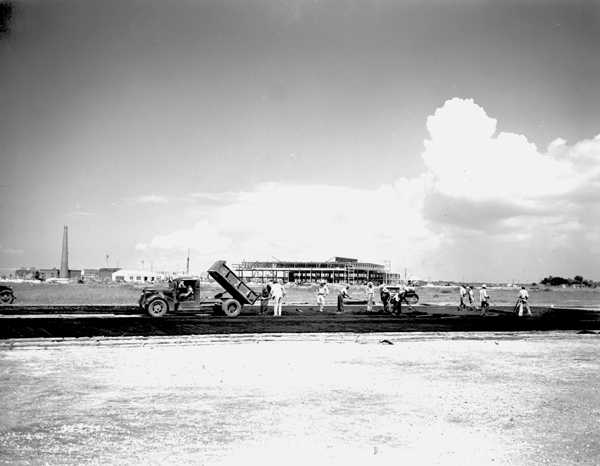U.S. Naval Air Station a.k.a. Camp Leroy Johnson
The U.S. Naval Air Station, (which would make way in the not too distant future for Louisiana State University at New Orleans, now the University of New Orleans) and, above it, Pontchartrain Beach. During World War II, the long factory building above Pontchartrain Beach at Franklin Avenue housed Consolidated Vultee Aircraft Co., which built seaplanes. By 1948 the facility had been converted to private industrial use. Today, the Levee Board occupies the property.
Source: New Orleans Public Library--Images of the Month
http://www.nutrias.org/~nopl/monthly/sept98/sept9810.htm
 Spreading asphalt for one of the two runways at the base. The runways are
Spreading asphalt for one of the two runways at the base. The runways are
built to grade and drainage structures built by WPA labor. Actual laying of
asphalt is being performed by contract. Unfinished hangar for the base is shown
in the background.
Source: New Orleans Public Library--WPA Photograph Collection
http://www.nutrias.org/~nopl/photos/wpa/images/02082.jpg
An Article from Best of New Olreans:
Hey Blake,
A friend of mine knows I am a New Orleanian and
asked me about the old days of Pontchartrain Beach. Her daughter is at the New
Navy Office where the old Camp Leroy Johnson was, and she would like to put up a
bulletin board of any pictures and legends of the whole area. You can help her,
I am sure.
DOROTHY V. QUINTAS
Dear DOROTHY,
As you
probably have told your friend, the land that is now our beautiful lakefront
didn’t even exist until the 1930s. It was then that a seawall was built about
3,000 feet from shore, the space was filled in with sand pumped in from the
bottom of the lake, and a new waterfront was created. The plan was to build
residential sections, parks, beaches and boulevards. But then came World War II.
Beginning in 1942, military installations appeared almost overnight. The
reclaimed land between the New Orleans Lakefront Airport – then Shushan Airport
– and the old Coast Guard Station located near the Southern Yacht Club and West
End Park was transformed into military bases, hospitals and even a German POW
camp. While pictures of the military installations are not easy to find, there
are many people who are old enough to remember when the war was a part of
everyone’s life, and they love to reminisce.
Pontchartrain Beach
Amusement Park moved to its site at the end of Elysian Fields Avenue in 1939 and
was the place to go until it officially closed in September 1983. Since the
closing was such an important but sad event, there were many stories and
pictures in Gambit and that other newspaper in town.
And after the war,
UNO – originally LSUNO – came into existence in 1958 and has not stopped
improving and expanding yet. They, of course, have photos of every phase of the
development of this fine university.
The story of Camp Leroy Johnson is
a special one. The camp was part of the lakefront for 22 years until it was
closed for economic reasons in July 1964 at a sunset ceremony in which the flag
was lowered for the last time. It was turned over to Lt. Col. Gilbert H. Folz
Sr. and S. Sgt. Anthony F. Messina, both of whom had enlisted during the 1940s.
They presented the flag to Col. Edward P. Ketchum Jr., the commanding officer.
The base that had opened in 1942 was originally known as the New Orleans
Army Air Base. However, in 1947, it was renamed for a very brave soldier from
Oakdale, La., who had entered the Army during World War II. Sgt. Leroy Johnson
was in the Philippines during the battle of Leyte when he and his squad were
directed to survey a ridge held by Japanese troops. They managed to take out an
entrenched machine gun with hand grenades, but then the Japanese started
throwing grenades back. When two of the grenades landed right next to Johnson’s
men, he sacrificed himself by falling full length on the grenades. His body took
the full force of the explosive charge, and he died shortly thereafter.
The valiant Sgt. Johnson was posthumously awarded the Medal of Honor for
'his outstanding gallantry in sacrificing his life for his comrades … in a
shining example of the highest tradition of the United States Army.'
--------------------------------------------------------------------------------
NOTE: While we’re on the subject of the lakefront that used to be, I have
good news. A while back a reader asked about a picture and some history on the
very popular restaurant and bar that used to be at 7039 Canal Blvd: The Rockery
Inn – 'Famous for Fried Chicken.' I wrote about the history of this neighborhood
establishment that was popular from the 1930s to 1969 when it closed to make
room for the Signorelli Building. Several folks sent stories of their memories
of good times at the old place. However, thanks to Fred Sahuc, I learned that
there is a great black-and-white picture located at the Amoco station at Canal
and Robert E. Lee boulevards that will bring back the memories.
Source:
http://www.bestofneworleans.com/archives/2001/0403/feat-blak.html


 Spreading asphalt for one of the two runways at the base. The runways are
Spreading asphalt for one of the two runways at the base. The runways are